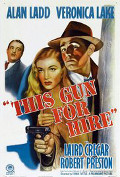
Directed by
Frank Tuttle
80 minutes
Rated M
Reviewed by
Bernard Hemingway

This Gun For Hire
Although this black and white noir-ish thriller is credited with making Alan Ladd a star after many years as a struggling actor I can’t say I found him particularly credible as a ruthless contract killer. Fortunately however he is literally and metaphorically helped out by Veronica Lake, then at the peak of her career. Although she was a bigger star than he at the time the height-challenged (literally as he was 5' 6", she 4'11") pairing worked at the box office and they went on to co-star in two other Paramount noir films, The Glass Key (1942) and The Blue Dahlia (1946).
Ladd plays Raven, a psychologically-disturbed hitman who in the opening scene slaps around a slatternly housemaid and shortly thereafter plugs a couple of would-be blackmailers in cold blood. The film does not deliver on this promising beginning however, quickly slowing down under Tuttle’s perfunctory direction for lots of bumbling police work (there are few instances to compare with the LAPD incompetence here) and a dull performance by Robert Preston as Lake’s squeaky clean detective boyfriend only accentuating the creaky core idea of the unmasking of an Axis sympathising industrialist (Tully Marshall) selling poison gas to the Japs.
Scriptwriters Albert Matz and W.R.Burnett transposed the Grahame Greene novel on which the film is based from London to L.A. and stitched in the war-time propaganda and an abused-childhood explanation of Ladd’s pathology. As a result this is far from being amongst the better of Greene adaptations. Although at times the dialogue crackles with suitable cynicism there is a tad too much of the redemptive to suit the noir style, not least of which is the film's dutifully corny ending.
For nostalgia buffs however the film offers pleasures enough. Although Lake is too subdued to have much impact she is not only elegant throughout but sings a couple of show tunes and Laird Cregor camps it up delightfully as an effete stooge for the old industrialist whilst the pursuit scene in the deserted gasworks, strikingly photographed by John Seitz, anticipates Raoul Walsh’s similar setting in White Heat (1949).
Want something different?





